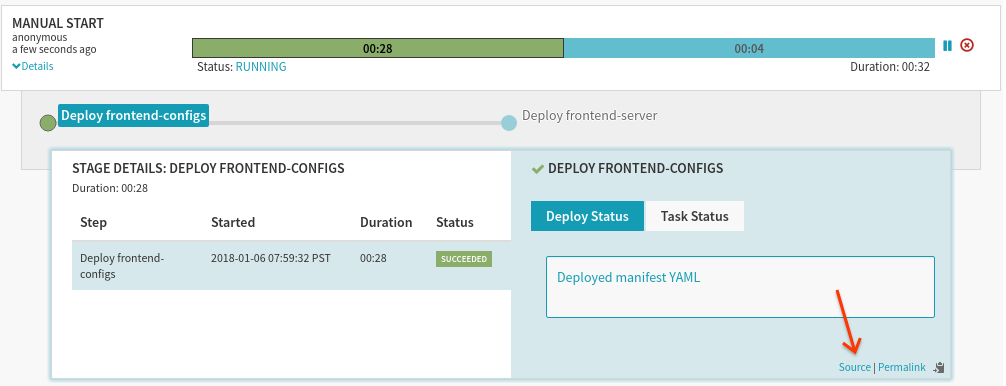Artifacts In Kubernetes
Manifests as artifacts
There are two ways to deploy a manifest:
- The manifest is supplied statically to a pipeline as text
- The manifest is supplied as an artifact
The image below shows a deploy stage that deploys a manifest stored in a GCS bucket:

Depending on how this pipeline is configured, it will only run when the referenced file in GCS is modified.
Kubernetes objects as artifacts
Once a manifest is successfully deployed using a pipeline (either from text or an artifact containing text), it is injected back into the pipeline’s context as an output of the deploy stage. Why this is useful is explained below , but for now focus on the distinction between…
An artifact representing a manifest stored as text in github:
{ "type": "github/file", "name": "manifests/frontend-configs.yml", "reference": "https://api.github.com/repos/your-application/..." }An artifact representing a deployed kubernetes object:
{ "type": "kubernetes/configMap", "name": "frontend-configs", "location": "prod", "version": "v001" }
As described in the manifests as artifacts section, a deploy stage would consume artifact 1, but produce artifact 2 as an output.
When running pipelines, you can always check the produced outputs for any stage by examining the execution’s “source” directly:

Versioned Kubernetes objects
According to the
Kubernetes reference
documentation
,
certain resources are “versioned,” meaning anytime a change is made to an
object’s manifest and deployed using Spinnaker, it is redeployed with a
new version suffix (-vNNN). This is critical to supporting immutable
deployments, as rolling out new ConfigMaps, secrets, or other versioned
resources should require any manifests that reference them to be updated as
well. Luckily, Spinnaker makes handling these updates easy, as explained
below
.
Binding artifacts in manifests
Generally, artifacts represent resources that you update as a part of your deployment/delivery pipelines. Given that Docker images and ConfigMaps are what will likely be updated within a manifest, we provide easy, first-class ways of injecting them into your manifests. If you’re familiar with Pipeline Expressions and are curious why we don’t just rely on those, read why not pipeline expressions below.
Spinnaker binds artifacts in your manifest based on a simple heuristic:
When a field’s referenced type and value match an incoming artifact’s type and name, the field’s value is replaced with the artifact’s reference
A “field’s referenced type” sounds ambiguous, but in practice it’s
straightforward. The field spec.template.spec.containers.*.image always
refers to a Docker image, so clearly it matches the artifact type
docker/image. The field spec.template.spec.volumes.*.configMap.name
always refers to a ConfigMap, so it clearly matches the artifact type
kubernetes/configMap. The same logic applies throughout.
Let’s go through an example to make this clear:
We have the following manifest to be deployed in a Spinnaker pipeline:
apiVersion: apps/v1
kind: Deployment
metadata:
labels:
app: nginx
name: nginx-deployment
spec:
replicas: 3
selector:
matchLabels:
app: nginx
template:
metadata:
labels:
app: nginx
spec:
containers:
- image: gcr.io/my-images/nginx # possible artifact
name: nginx
ports:
- containerPort: 80
volumeMounts:
- mountPath: /opt/config
name: my-config-map
volumes:
- configMap:
name: configmap # possible artifact
name: my-config-map
And when the deploy stage executes, we have the following artifacts in our execution context (likely populated from a trigger event, or prior deployments):
[
{
"type": "docker/image",
"name": "gcr.io/my-images/nginx",
"reference": "gcr.io/my-images/nginx@sha256:0cce25b9a55"
},
{
"type": "kubernetes/configMap",
"name": "configmap",
"version": "v001",
"location": "default",
"reference": "configmap-v001"
}
]
The ConfigMap and Docker image are replaced by the artifacts in the context, and the resulting manifest is deployed into your cluster:
apiVersion: apps/v1
kind: Deployment
metadata:
labels:
app: nginx
name: nginx-deployment
spec:
replicas: 3
selector:
matchLabels:
app: nginx
template:
metadata:
labels:
app: nginx
spec:
containers:
- image: gcr.io/my-images/nginx@sha256:0cce25b9a55 # bound by spinnaker
name: nginx
ports:
- containerPort: 80
volumeMounts:
- mountPath: /opt/config
name: my-config-map
volumes:
- configMap:
name: configmap-v001 # bound by spinnaker
name: my-config-map
Why not pipeline expressions?
Pipeline Expressions offer a great way to reference pipeline context programmatically using short snippets of code. Of course, it’s possible to construct expressions that allow you to reference the Docker image’s reference that triggered a pipeline, or the name of the ConfigMap you deployed in a prior stage. But we want an easier way to express updates to these resources, leaving your Kubernetes Manifests natively deployable without making Spinnaker’s expression engine a hard dependency.